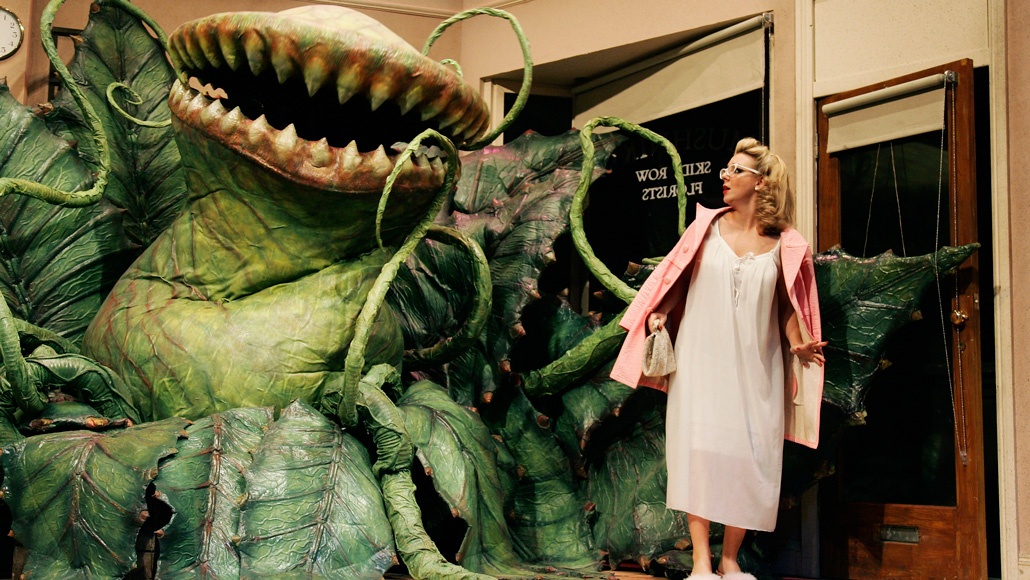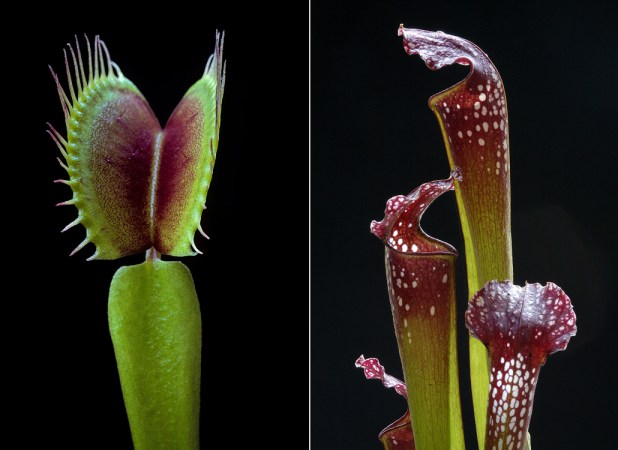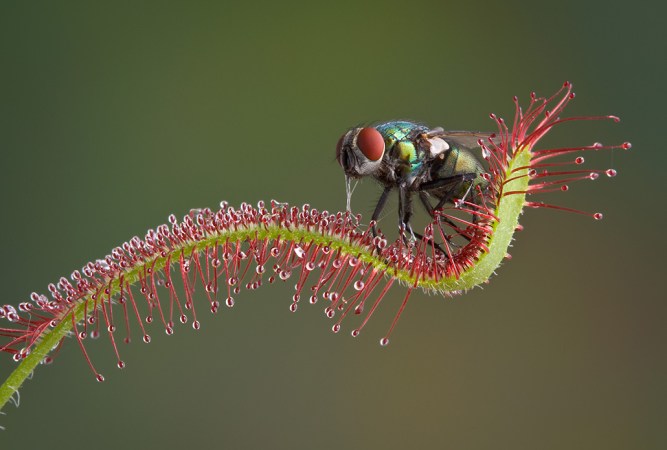Could a plant ever eat a person?
Carnivorous plants can catch small animals, but a human-eater would need a major upgrade

It’s only in movies and plays — such as this staging of Little Shop of Horrors in London, England, in 2009 — that plants are able to eat people.
MJ Kim/Staff/Getty Images
Share this:
- Share via email (Opens in new window) Email
- Click to share on Facebook (Opens in new window) Facebook
- Click to share on X (Opens in new window) X
- Click to share on Pinterest (Opens in new window) Pinterest
- Click to share on Reddit (Opens in new window) Reddit
- Share to Google Classroom (Opens in new window) Google Classroom
- Click to print (Opens in new window) Print
There’s no shortage of man-eating plants in popular culture. In the classic movie Little Shop of Horrors, a gigantic plant with shark-sized jaws needs human blood to grow. The Piranha Plants of the Mario Bros. video games hope to make a snack out of our favorite plumber. And in The Addams Family, Morticia owns an “African Strangler” plant with a pesky habit of biting humans.
Many of these villainous vines are based on real vegetation: carnivorous plants. These hungry flora use traps such as sticky leaves, slippery tubes and hairy snap-traps to catch insects, animal poop and the occasional small bird or mammal. Humans aren’t on the menu for the 800 or so carnivorous plants found worldwide. But what would it take for a carnivorous plant to capture and consume a person?
Don’t fall in
Carnivorous plants come in many shapes and sizes. One common type is the pitcher plant. These plants lure prey into their tube-shaped leaves using sweet nectar. “You could get a really tall, deep pitcher that would be effective as a pitfall trap for larger animals,” says Kadeem Gilbert. This botanist studies tropical pitcher plants at Michigan State University in Hickory Corners.
The lips of these “pitchers” have a slippery coating. Insects (and sometimes small mammals) that lose their footing on this coating plunge into a pool of digestive enzymes. Those enzymes break the animal’s tissue down into nutrients that the pitcher plant absorbs.
Pitcher plants aren’t equipped to make regular meals out of mammals, though. While larger species can trap rodents and tree shrews, pitcher plants mainly eat insects and other arthropods, says Gilbert. And the few pitcher plant species large enough to snare mammals are probably after these animals’ poo rather than their bodies. The plants catch poop left by small mammals as they lap up the plant’s nectar. Consuming this predigested material would use less energy than digesting the animal itself, Gilbert says.
A man-eating plant would want to save energy when it could. “The depictions in Mario Brothers and Little Shop of Horrors seem less realistic,” says Gilbert. Those monstrous plants chomp, flail their vines and even run after people. “It takes a lot of energy for fast movement.”
Both of those fictional plants take cues from the real-life Venus flytrap. Instead of sporting a pitcher, a flytrap relies on jaw-like leaves to catch prey. When an insect lands on these leaves, it triggers tiny hairs that prompt the leaves to snap shut. Triggering these hairs produces electrical signals that use up valuable energy, Gilbert says. More energy is then needed to produce enough enzymes to digest the plant’s prey. A giant flytrap would need massive amounts of energy to move electrical signals across its hefty leaves and also produce enough enzymes to digest a human.

Barry Rice agrees that the ideal man-eating plant wouldn’t move. He studies carnivorous plants at the University of California, Davis. All plants have cells lined with a rigid cell wall, Rice notes. This helps give them structure but makes them “terrible at bending and moving around,” he says. Real carnivorous plants with snap-traps are small enough that their cellular structure doesn’t limit any moving parts. But a plant large enough to catch a person? “You’d have to make it a pitfall trap,” he says.
The Sarlaccs of the Star Wars universe offer a good example of how man-eating plants might work, Rice says. These fictional beasts bury themselves in the sands of the planet Tatooine. They lie motionless, waiting for prey to fall into their gaping mouths. A massive pitcher plant growing at ground level would essentially become a huge, living pit. A careless human that falls in could then be slowly digested by powerful acids.
Digesting a human may be more trouble than it’s worth, though. The extra nutrients from undigested prey would promote the growth of bacteria. If the plant takes too long to digest a meal, the corpse could begin to rot inside the plant, Rice says. Those bacteria could end up infecting the plant and causing it to rot, too. “The plant’s got to be able to make sure it can take those nutrients out of there,” says Rice. “Otherwise, you’re gonna get a compost pile.”
A sticky affair
Pitcher plants and snap-traps, though, may offer humans too many chances to wriggle free. Large mammals could escape by simply thrashing about, says Adam Cross. He’s a restoration ecologist at Curtin University in Bentley, Australia, and has studied meat-eating plants. A person trapped in a pitcher plant could easily punch a hole through its leaves to drain the fluid and escape, he says. And snap-traps? “All you’d need to do is just cut or pull or tear your way out.”

The glue-like traps of sundews, however, would prevent a person from fighting back. These carnivorous plants use leaves covered in tiny hairs and sticky secretions to capture insects. The best human-trapping plant would be a massive sundew that carpets the ground with long, tentacle-like leaves, Cross says. Each leaf would be covered in big globs of a thick, sticky substance. “The more you struggled, the more you would become enmeshed and the more your arms would be unable to function properly,” says Cross. The sundew would subdue a person through exhaustion.
Sundews’ sweet scents may entice insects, but that’s probably not enough to lure humans into a trap. Animals are rarely attracted to plants unless the critters are looking for a place to sleep, something to forage for or another resource that can’t be found elsewhere, Cross says. And for a human, the reward of going near a man-eating sundew would need to be worth the risk. Cross recommends a fleshy, nutritious fruit or a reliable source of water. “I think that’s the way to do it,” says Cross. “Bring them in with something tasty, and then munch on them yourself.”







